|
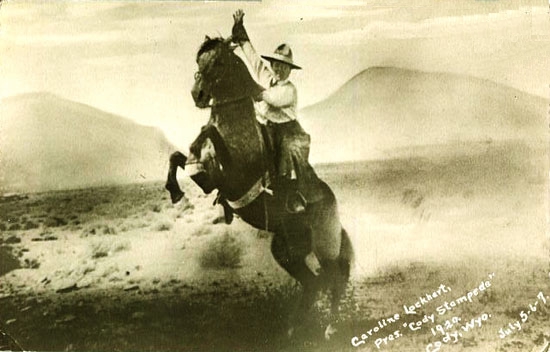
Caroline Lockhart, 1920. Photo by F. J. Hiscock.
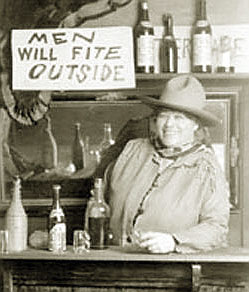 Caroline Lockhart
Caroline Lockhart
Prior to becoming a newspaper writer and after attendance at the "Monrovian Seminary for
Young Ladies," Miss Lockhart appeared on the stage and in a lion taming act in a
circus. She actually entered the lion's cage the day after the lion killed her
predecessor. As a newspaper writer, she donned diving gear to go to the bottom of Boston Harbor and jumped four floors to test the
Boston Fire Department safety net. Among her novels were Me-Smith and The Lady Doc.
The Lady Doc in its
depiction of the fictional town of "Crowheart" was well
received nationally, but in Cody the novel was greeted with a degree of frostiness which might remind
one of those clear chilling winds which blow out of the northwest on a January morning.
Indeed, Miss Lockhart's books were removed from
the shelves in the library. Miss Lockhart responded with a salvo against one of the members of the
Library Board. Miss Lockhart wrote that the member was "one of those women who could go
anywhere in the world without fear of molestation from the
opposite sex." One of those active with the library and who assisted in obtaining assistance in obtaining financing with
Andrew Carnegie was a town physician, Dr. Frances Margaret Lane (1873-1938).
The general nastiness continued until in 1922 it boiled over into an issue as to the future direction of the Stampede with
Lockhart accusing some of wanting to turn it into a Chautaugua.
The characters in Lady Doc were regarded as depictions of well-known Cody residents including
George Beck, Daisy Beck, Bronson Rumsey, Jake Schwoob manager of the Cody Trading Company, and Dr. Lane. The depictions were nasty-nasty beyond satire.
What caused Lockhart to dislike leading citizens of Cody is subject to speculation which does not give a favorable view of Lockhart.
Dr. Lane had arrived in Cody in 1902. She had graduated from the Hering Medical School in Chicago with honors in 1898. At first
she had gone to Victor, Colorado, before coming to Cody. She had a contract with the federal government to
provide medical services for the workers on the Shoshone Dam. Dr. Lane was a founder of the Christ Episcopal Church in Cody and was a member of the
Cody Club. She and Dr. James Bradbury started the local hospital. Later she became
the County Health Officer and was active relating to stopping the spread of the Spanish Flu. She was active with the School Board and the Chairman of the Wyoming Branch of the
National Woman's Party.
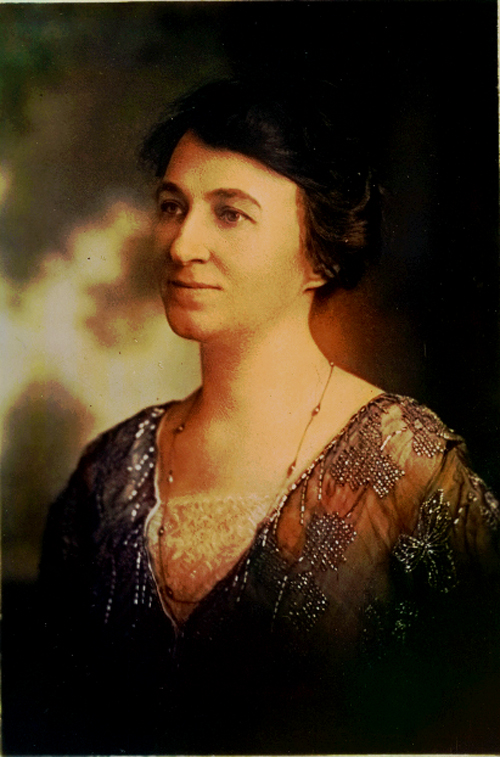
Dr. Frances M. Lane.
We all enjoy seeing the foibles of the well-known being exaggerated and satirized. That is the
essence of a good roast, but The Lady
Doc perhaps went too far. No one was safe. Not even Cody's Cowboy Band. Miss Lockhart wrote of the Band as:
* * * a conflict of
sounds which resembled the efforts of a Chinese orchestra
* * * making superhuman endeavors to march
and yet produce a sufficiently correct number of notes
from the score of "A Hot Time in the Old Town" to
make that American warcry recognizable * * *"
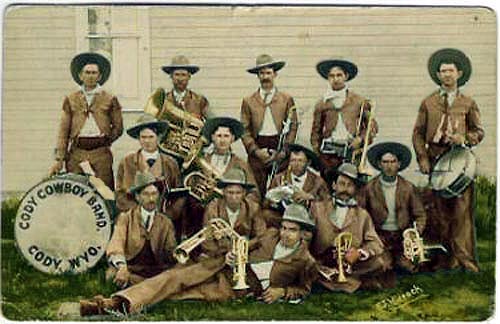
Cody Cowboy Band. Photo by F. J. Hiscock.
If the novel's central villainess, the Lady Doc, Dr. Emma Harpe, was taken to be Dr. Lane, Miss Lockhart
wrote with a heavy hand. The central character Dr. Harpe was drawn as an incompetent, greedy money grubbing abortionist,
who was forced to leave Nebraska under threat of losing her medical license for killing a patient in
a forbidden operation. Dr. Harpe was depicted as one who stole from patients while they
were under ether. The efforts of George Beck to bring irrigation to the Basin were unmercifully grilled. Miss Lockhart
depicted the prospective purchasers of new farms coming to see
"the land 'where
the perfumed zephyrs fanned the cheeks of men and
brothers!' Coming to breathe 'the Elixir of Life,'
while they inspected that portion of the desert which
was 'blooming like the rose!'" as arriving in a dust storm:
The
committee of prominent citizens met [the train] where the
cinder platform had been before it blew off.
The excursionists looked through the car-windows
to see members of the Cowboy Band with one arm
locked around the frame-work of the water-tank and
with the other endeavoring to keep divers horns, trombones
and flutes in their mouth. No sound reached the
ears of the excursionists owing to the fact that they
were on the windward side of the band and the stirring
notes of "Hot Time in the Old Town" were
going the other way.
Mr. Symes's [Miss Lockhart's thinly disquised Beck] neat speech of welcome was literally
blown out of his mouth * * * .
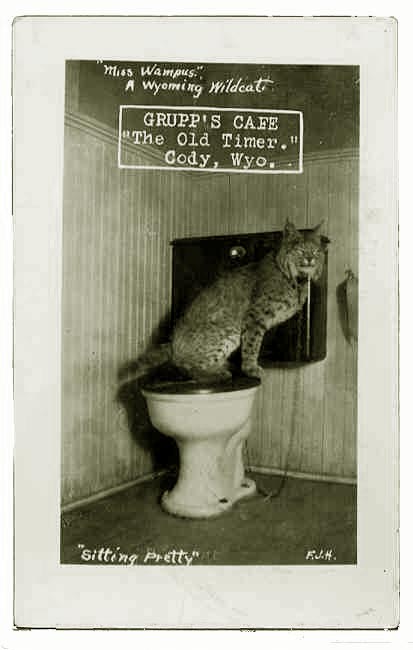 Wampus Kitty. Photo by F. J. Hiscock.
Wampus Kitty. Photo by F. J. Hiscock.
To needle those who took offense, Miss Lockhart circulated rumors that a movie
version of The Lady Doc was to be filmed in Cody. Her earlier novel The Man from Bitter Roots was filmed at the
Hargreaves Ranch. Another movie, the Diva Pictures potboiler The Hell Cat starring
Geraldine Farrar was also filmed in Cody. Miss Lockhart's description of Crowheart
could well have fit the early years many of the towns in the Bighorn Basin:
Crowheart was platted on a sagebrush "bench"
on a spur of a branch railroad. The snow-covered
peaks of a lofty range rose skyward in the west. To
the north was the solitary butte from which the town
received its name. To the south was a line of dimpled
foothills, while eastward stretched a barren vista of
cactus, sand, and sagebrush. A shallow stream flowed
between alkali-coated banks on two sides of the town.
In the spring when melting mountain snows filled
it to overflowing, it ran swift and yellow; but in the
late fall and winter it dropped to an inconsequential
creek of clear water, hard with alkali. The inevitable "
Main Street" was wide and its two business blocks
consisted of one-story buildings of log and unpainted
pine lumber. There was the inevitable General Merchandise
Store with its huge sign on the high front,
and the inevitable newspaper which always exists,
like the faithful at prayer, where two or three are
gathered together. There were saloons in plenty
with irrelevant and picturesque names, a dance hall
and a blacksmith shop. The most conspicuous and pretentious
building in Crowheart was the Terriberry
House, bilious in color and Spartan in its architecture,
located in the centre of Main Street on a corner.
The houses as yet were chiefly tar-paper shacks or
floored and partially boarded tents, but the sound of
the saw and the hammer was heard week-days and
Sundays so no one could doubt but that it was only
a question of time when Crowheart would be comfortably
housed. There was nothing distinctive about
Crowheart; it had its prototype in a thousand towns
between Peace River and the Eio Grande; it was typical
of the settlements which are springing up every
year along the lines of those railroads that are stretching
their tentacles over the Far West.
In 1919, Miss Lockhart assumed ownership of the Park County Enterprise, which she renamed the
The Cody Enterprise. During her ownership of the paper, she voiced in typically colorful manner her
opposition to Prohibition. Miss Lockhart's personal distillery is on display in a local
museum. Her "gorgeous and glowing speech" was cited by
H. L. Mencken in his 1921 The American Language.
The newspaper was also used to voice Miss Lockhart's opposition to the plan of the Montana
Fish and Game Department to exterminate the bobcat. At the newspaper, the office cat was
a lynx named "Wampus Kitty." The cat is immortalized as the name of a room in a local
bed and breakfast. In 1925, Miss Lockhart sold the paper, later writing of the passing of the editorship:
Out of a vast experience with burglars, blacksmiths, ignoramuses, and imbecilles, whom we
have hired under the misapprehension that they were editors, printers or machine operators,
we feel we are qualified to judge. So taking the office cat...(actually a pet lynx), we handed him the key
and may God have mercy on his soul."
Both the newspaper and the Stampede continue today. The tradition of colorful
writing in the Enterprise continues with the columns of Doug Blough, "If I Were Running This Town," and
Carole Cloudwalker, "Postcards from the High Ground," both of which this writer must
confess to occasionally reading. Recently [October 2003], Blough wrote of his hitting the
parked car of a local circuit judge as
"the sickening, metal-on-metal raking of 1978 Ford truck groping 2002 Honda
Accord. (These May/December romances often turn tragic.)" Blough attributed his
hitting the circuit judge's vehicle to an absence of drink.
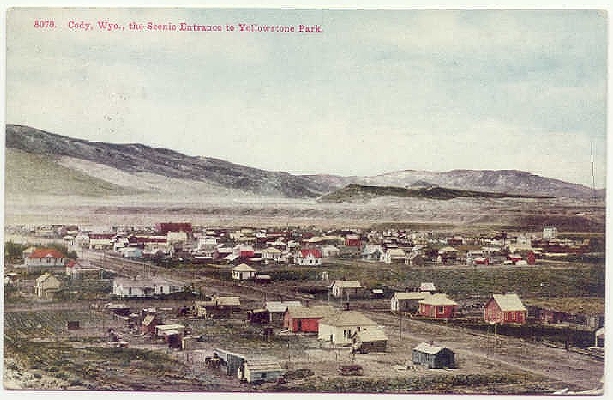
Cody, 1906
Next Page: Cody continued.
|